![]()
![]()
![]()
Use LEFT and RIGHT arrow keys to navigate between flashcards;
Use UP and DOWN arrow keys to flip the card;
H to show hint;
A reads text to speech;
65 Cards in this Set
- Front
- Back
|
What is a stream staff gauge?
|
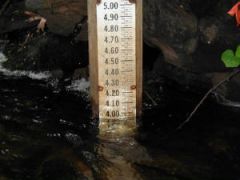
Non-recording gauge.
|
|
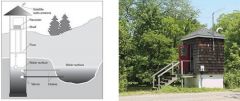
This is called a ____ ____ or measuring station.
|
Stilling well
|
|
|
Stream stage is measured from where?
|
The datum. Which can be any predetermined elevation.
|
|
|
What is the best way to measure stream velocity?
|
Tracer method.
|
|
|
What is discharge measured in?
|
Meters cubed per second. (m3/s)
|
|
|
How do you compute discharge?
|
Velocity x depth x width = Q
(or cross-section area m2 x m/s velocity) |
|
|
What is the letter that represents discharge rate?
|
Q
|
|
|
Why must a stream's cross section be periodically re-measured?
|

The cross-section area (width x depth) can change due to stream dynamics, which changes the discharge rate and rating curve.
|
|
|
What does a hydrograph tell us?
|
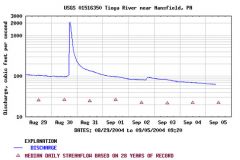
It shows the change in discharge of a stream over time at a given point.
|
|
|
In a watershed which order would be at the top and at the bottom? List from top to bottom:
a. 1st, 2nd, 3rd b. 3rd, 2nd, 1st |
a. 1st, 2nd, 3rd
|
|
|
A watershed is determined by what feature(s):
a. Rivers b. Plunging anticlines and synclines c. Elevation d. Political boundaries (states and counties) |

c. Elevation
|
|

Point out peakflow and baseflow on this graph:
|
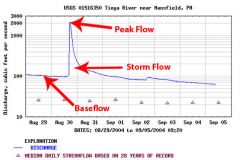
|
|
|
What is river baseflow?
|
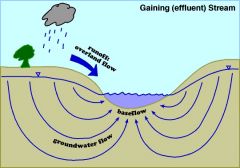
Ground water entering the river maintaining it's flow.
|
|
|
What is the river Base Level?
|
The lowest point a flowing water body can flow to. Most often the ocean.
|
|
|
Stream Competence is the:
|
Maximum bed load particle size (pebble, rock boulder)
|
|
|
Stream Capacity is the:
|
The measure of the total sediment a stream can carry (excluding water).
|
|
|
Fan shaped river deposits are called:
|
Delta's or Alluvial fans
|
|
|
A _____ is a fan shaped sediment deposit associated with the ocean.
|
Delta
|
|
|
A _____ is a fan shaped sediment deposit associated with another river.
|
Alluvial fan
|
|
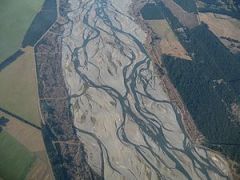
What type of stream is this?
|
Braided
|
|
|
Braided streams have a _____ sediment load, and _______ discharge.
|
LARGE sediment load, and VARIABLE discharge.
|
|

What type of stream is this?
|
Meander
|
|

The green area represents the:
|
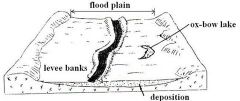
Floodplain
|
|
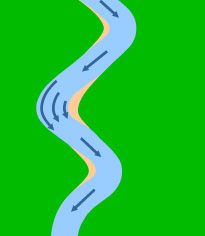
Identify the Cutbank and the Point Bar.
|

|
|
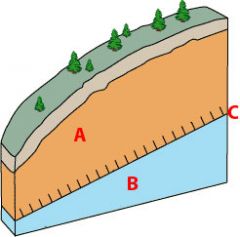
Label items A B C.
|
a. unsaturated zone
b. saturated zone c. water table |
|
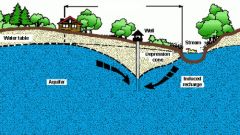
What is the are between the arrows called?
|

Arear of influence.
|
|
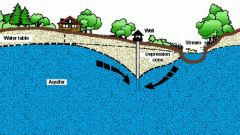
The well's cone of depression is doing what to the stream?
|
Causing stream flow to the aquifer draining the stream.
|
|
|
Infiltration capacity is the:
|
Amount of water soil can hold.
|
|
|
98% of unfrozen fresh water is:
|
groundwater
|
|
|
25% of all fresh water is:
|
groundwater
|
|
|
Ground water is primarily held in what part of the soil?
|
pore spaces
|
|
|
The phreatic zone is the zone of _____:
|
saturation (pore spaces filled with water)
|
|
|
The vadose zone is the zone of ________:
|
unsaturation (pre spaces fileld with air and water)
|
|
|
The majority of streamflow in this regions mountains is from ________.
|
Groundwater.
|
|
|
Aquifers represent what K value:
|
High (sand gravel sandstone fractured rock)
|
|
|
Aquitards represent what K value:
|
Low (clay silt shale unfractured rock)
|
|
|
K represents what in hydrology:
|
Hydraulic conductivity
|
|
|
What was Henry Darcy's purpose for his studies of hydrology?
|
To filter water.
|
|
|
What are the 3 key elements of Q?
|
Slope
Area Hydraulic Conductivity |
|
|
Aquifers are defined by an area of saturation that has ______ _______ of water.
|
Useful quantities (well or spring)
|
|
|
Stream competence is:
|
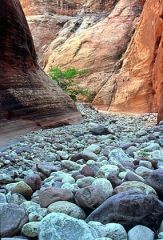
The maximum bed load size particle.
|
|
|
What is stream capacity?
|

The total amount of solid particulate carried by the river.
|
|

Name the types of stream load.
|

|
|
|
Where are the slowest and fastest currents in a stream?
|
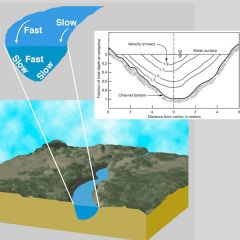
|
|
|
How would you or a team of researchers get the cross-sectional area of a stream?
|

|
|
|
Ground water pumping over a long time can lead to:
|
Subsidence (Mexico City example)
|
|
|
How are sinkholes formed by well pumping?
|
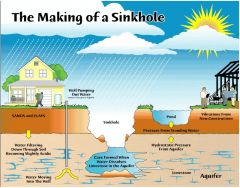
|
|
|
How can well pumping cause salt water intrusion?
|
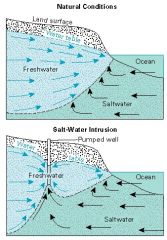
|
|
|
How does a septic system work, and what can it release into water tables?
|
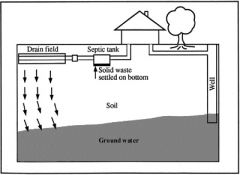
Bacteria, metals, nutrients, pathogens, residual medications from people...
|
|
|
What is L.U.S.T.?
|

Leaking Underground Storage Tank
|
|
|
What is one of the most important formations to find oil trapped in?
|
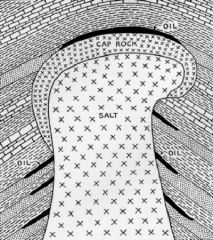
Salt Domes
|
|
|
Be able to label the Cap Rock (seal rock), Reservoir, and Source Rock
|
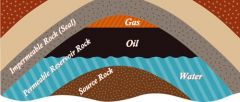
|
|
|
Where does oil source rock originate from?
|
Reefs, plants, microgorganisms burried and put under heat and pressure under the right conditions becomes oil. (over millions of years).
|
|
|
Where does oil source rock originate from?
|
Reefs, plants, microgorganisms burried and put under heat and pressure under the right conditions becomes oil. (over millions of years).
|
|
|
What are some other common traps oil and gas are found?
|
Anticlines, dip-slip faults, unconformities.
|
|
|
Where does oil source rock originate from?
|
Reefs, plants, microgorganisms burried and put under heat and pressure under the right conditions becomes oil. (over millions of years).
|
|
|
What are some other common traps oil and gas are found?
|
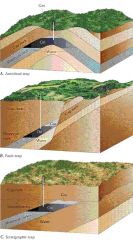
Anticlines, dip-slip faults, unconformities.
|
|
|
What do stratigraphers do for petroleum geology?
|

Determine the stratified layer sequence of rock formations.
|
|
|
Structural geologist do what for petroleum geology?
|
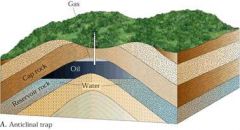
Interpret subsurface folds/faults/structures that may contain oil.
|
|
|
What is the average cost of drilling an oil well?
|
$125 per foot
|
|
|
What is the average depth of an oil well?
|
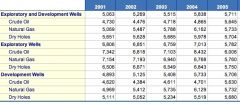
6000 ft.
|
|
|
Petroleum engineers determine what part of process?
|
How to drill.
|
|
|
Why might biologists and ecologists be employed by the petroleum industry?
|
To clean up the environmental messes.
|
|
|
Why are paleontologists hired by the petroleum industry?
|
It is paleontology that uniquely explains the element of geologic time and depositional environment to petroleum exploration.
|
|
|
Geophysicists perform what task in the petroleum industry?
|
Interprets seismic surveys of subsurface geology.
|

